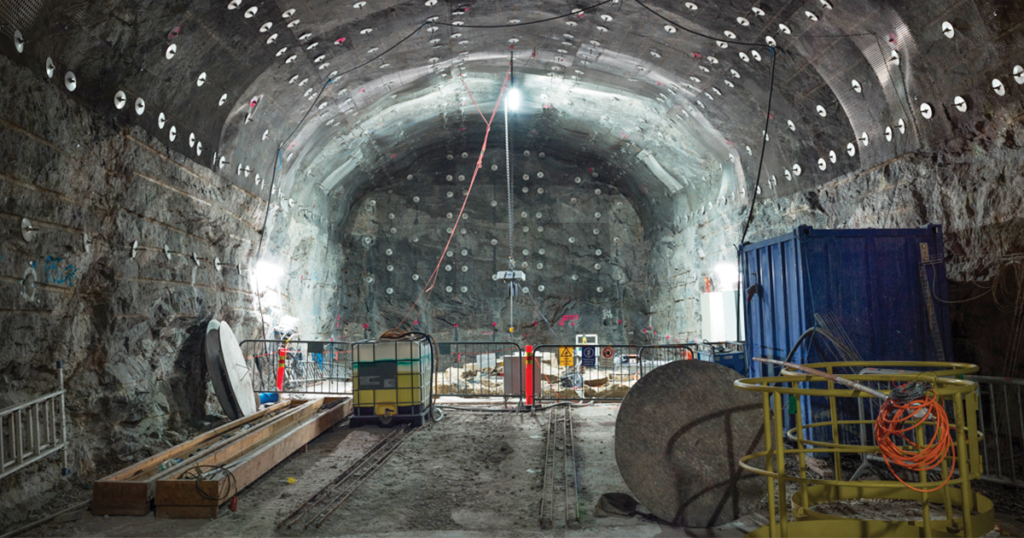
Underland: A Deep Time Journey by Robert Macfarlane; Norton, 488 pp., $27.95
Robert Macfarlane’s new book, like his earlier ones—about the hold of mountains on the human imagination, about wild places of the British isles, about walking along ancient routes, and about the language of nature writing itself—is exuberantly rich in its range of references and associations, poetically reflective, and breathtakingly well written. It takes him from the earth’s seemingly solid surface into the cracks and hollows beneath, from relatively shallow time—a few hundred or thousand years of recorded human history—to the deep time of the birth of the universe, and the far distant future when the radioactive wastes in a Finnish cavern will still be lethal. The idea of the underground as a place of deep time is not new. There the pioneer geologists of the 19th century had found evidence that the Earth was many millions of years old (and not, as the Bible suggests, a few thousand). The great 17th-century physician and essayist Thomas Browne wrote about how the discovery of burial urns spoke to the essence of what it means to be human. “It is often in the nature of our memory-making,” writes Macfarlane, “to wish to be able to address our dead at particular sites on the Earth’s surface.” But never has the underworld been explored with an eye and a heart more attuned to its wonder and meaning.
Macfarlane begins in Britain—in the mine-pocked landscape of the Mendip Hills of Somerset, where in 1797 two young men chasing a rabbit discovered a cave that held remains, including those of a young child, that had not seen the light of day for 10,000 years. He learns the art of “undersight”—seeing “disguised extents”—from the first of his many ciceroni. Then to a deep salt mine with chambers and passageways carved out by huge machines, running for many kilometers under Boulby in Yorkshire and beyond to the North Sea. There in the depths, a young physicist hopes to detect dark matter and to hear “the breath of the birth of the universe,” as if one needs to descend as far as possible from the heavens to hear the stars. Here, too, are old, abandoned mining machines, which bring Macfarlane to recall the even older bones of the ponies that labored and died in the darkness of 19th-century French mines. And finally to Epping Forest, where inches below the surface, a network of mycorrhizal fungi joins together the vast arboreal world above. The discovery of this below-the-ground ecology forces a change in how one views the world. It is perhaps the most astonishing underground of them all. Macfarlane reaches for “a language that recognizes and advances the animacy of the world.” And he comes close: arboreal tenderness.
He moves next to the underworld of Europe. First to the great caverns deep beneath Paris, created by thousands of years of quarrying the stone for the aboveground city, an urban world built by subtraction. I knew about the millions of bones stored there in the 18th century but not about the subcultures—the graffiti artists, musicians, and urban adventurers who live and create in its depths today. Then on to a starless river: the Timavo, on the northeastern border between Italy and Slovenia, like the starless rivers of antiquity—the Cocytus, the river of lamentation, and the Phlegethon, the river of heat—opening innocently to the world above and then flowing deeply and mysteriously through its interior. Freud would have been fascinated by sinkholes and the dreamlike quality of this porous landscape. Next, the hollow lands of Slovenia, the scene of many wartime and postwar murders and reprisals; the “terrain of the karst, [where] historical memory behaves like flowing water,” Macfarlane writes, “disappearing without warning, only to resurge under new names, in new places, with fresh force.”
And then to the ancient caves on a remote, nearly inaccessible coast of Norway, where Bronze Age people left their art, and to the labs of glacier scientists who teach Macfarlane that ice has a memory and a social history of its own. The melting permafrost reveals long-frozen bodies; the depths of glaciers indicate the atmosphere of the planet more than 100,000 years ago. And finally, the manmade caverns of Finland, where 6,500 tons of highly radioactive uranium wastes will be stored in 1.9-billion-year-old rock.
Limestone is a synecdoche for the wonder that informs this book. Speaking of the limestone Lascaux caves in southwestern France, Macfarlane tells us this rock “has the added curatorial power of often running a film of transparent calcium carbonate” over 20,000-year-old wall paintings, acting as a varnish and preservative. It is the most common stone of sepulcher, which is perhaps fitting. Dead sea creatures are its substance. The “dance of death and life” that goes into it make it, he thinks, “without doubt the liveliest, queerest rock” he knows.
This book is a page-turner not in its narrative sweep but in its lyrical granularity, its wild yet somehow controlled torrent of connections, and its steady beat of natural history. Inches below the soil are “gleaming spiders and red-bronze beetles battling over the leaves, a woodlouse curled up into a sphere, a green threadworm writhing through the humus.” I suggest going slowly.
Except in one regard. Lest readers think I have lost all critical judgment, allow me to say that Macfarlane’s mercifully short accounts of visiting the underworld could, for my taste, have been even shorter. His stomach flips on at least two occasions—a bloom of fear in his chest as he crosses a glacier; adrenaline, lactic acid buildup, and bloody fingernails in the Julian Alps. People who enjoy being terrified by damp, claustrophobic spaces, Stygian torrents, threatening storms, and similar inhospitable experiences will want to linger. The rest of us can move more quickly ahead.

